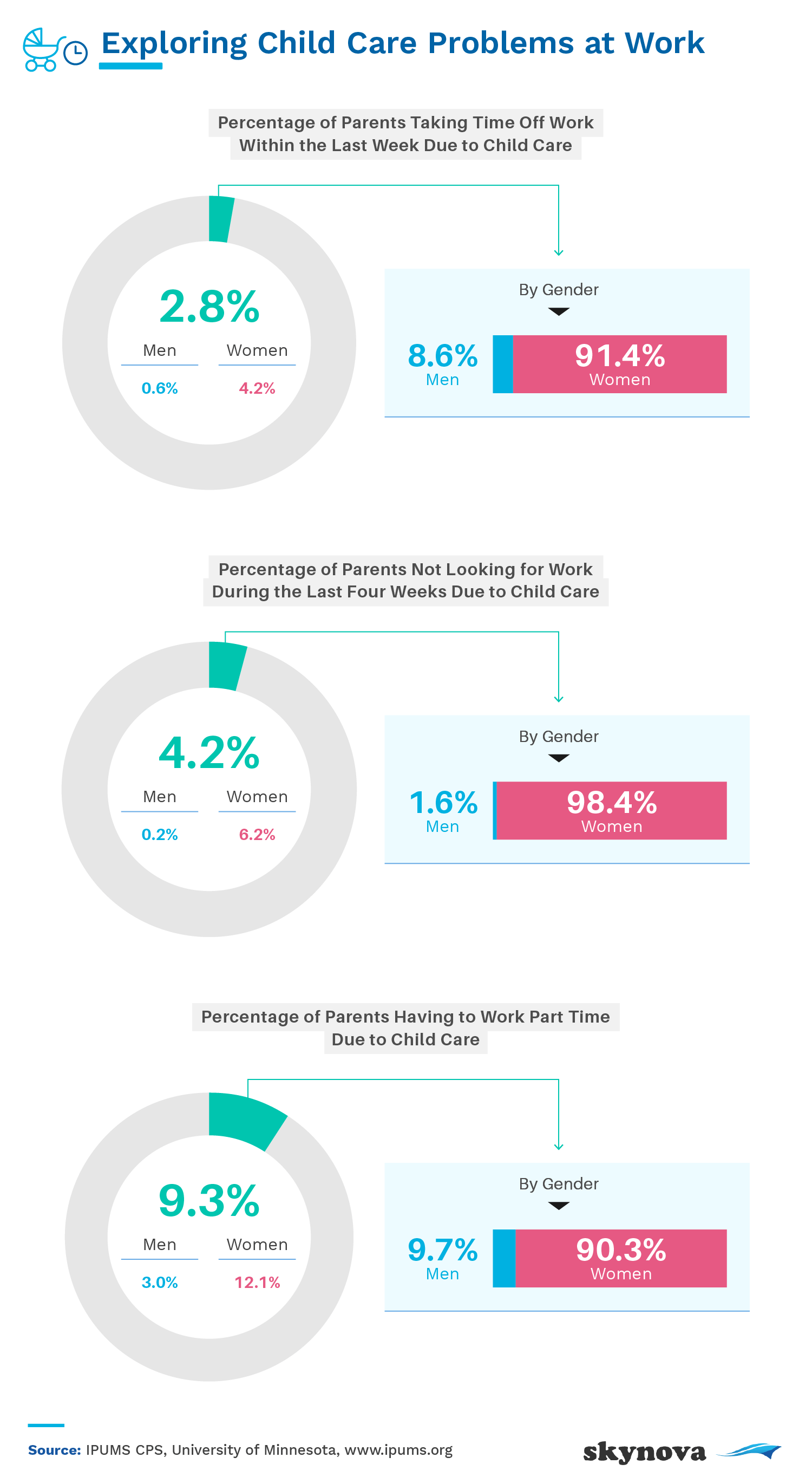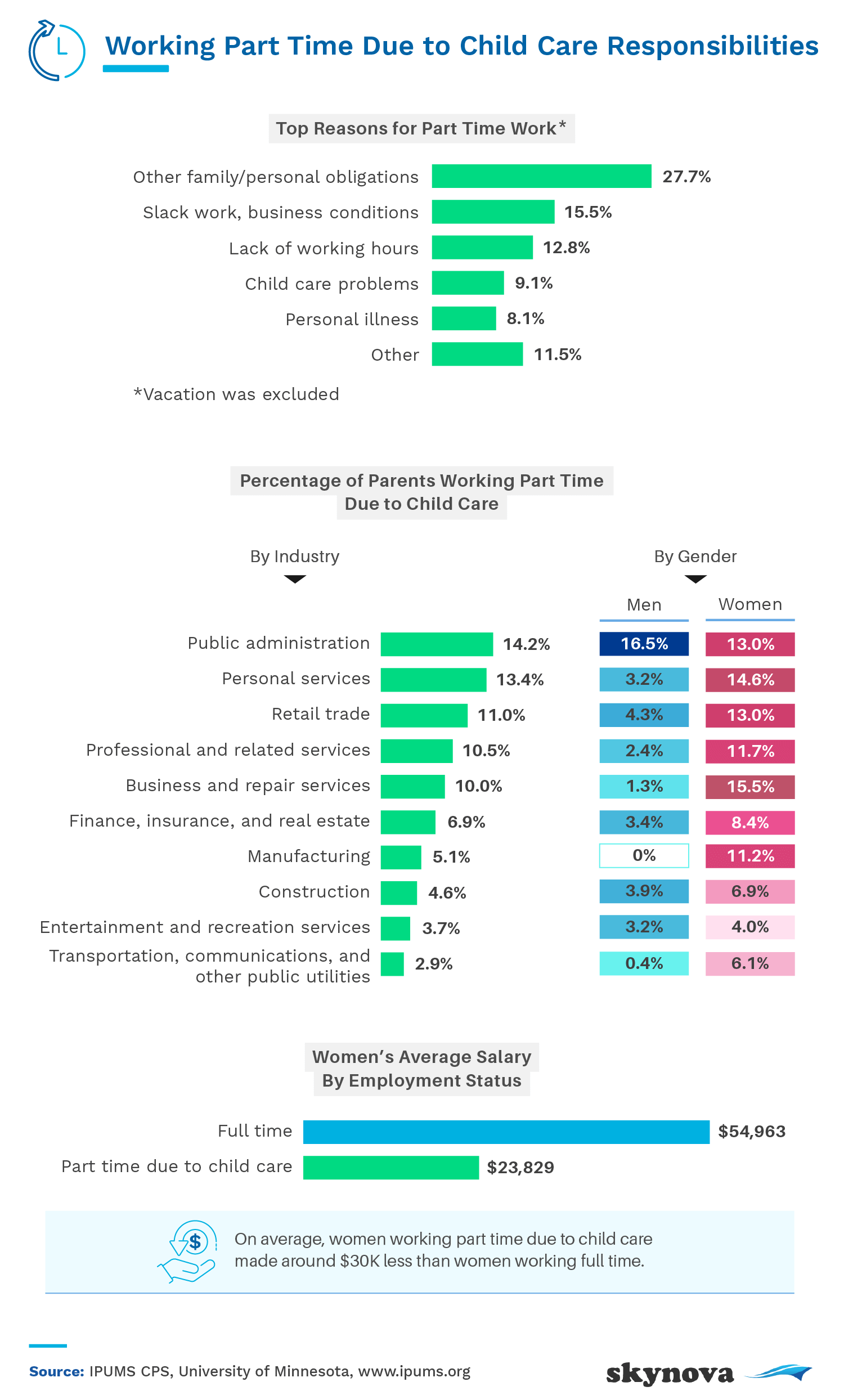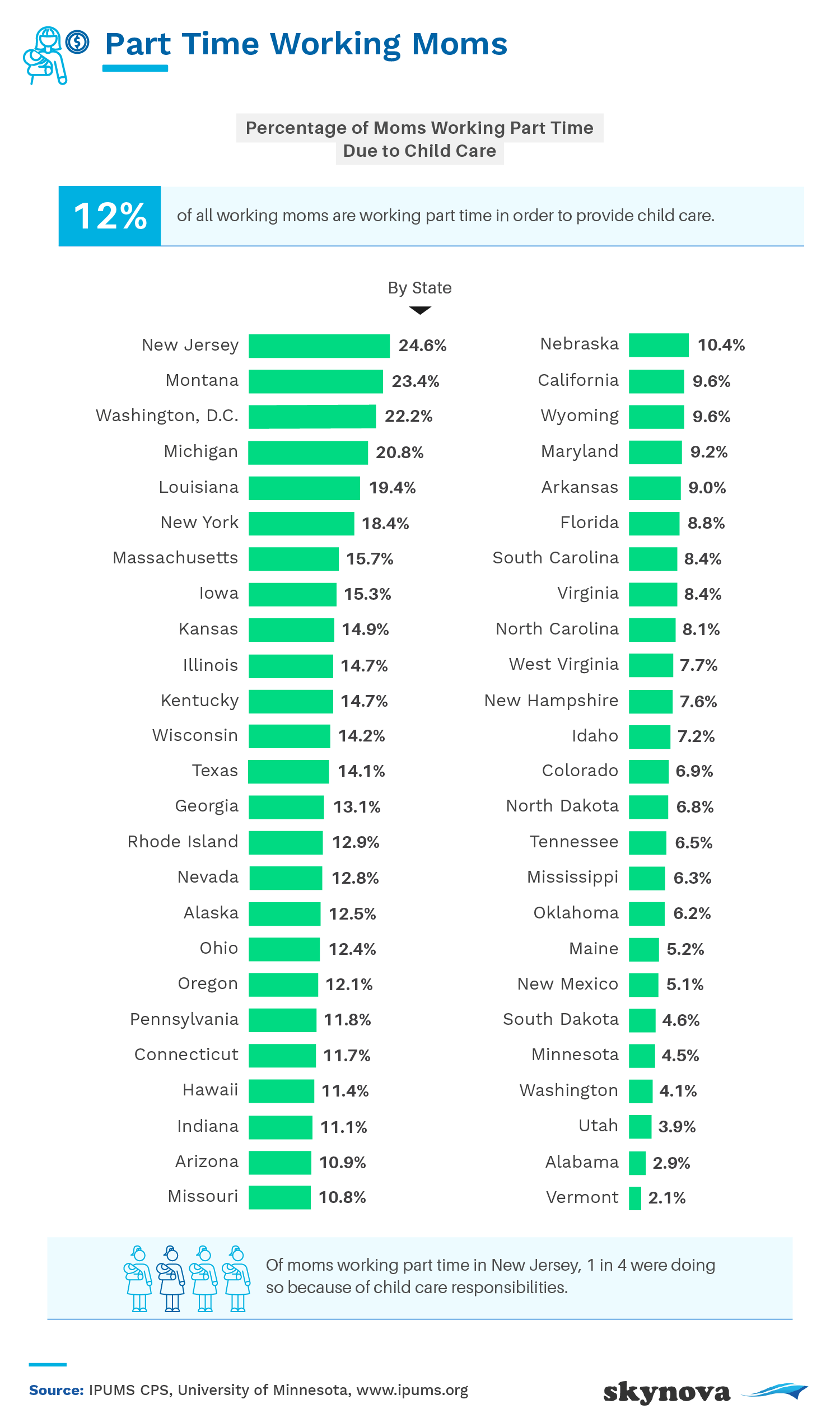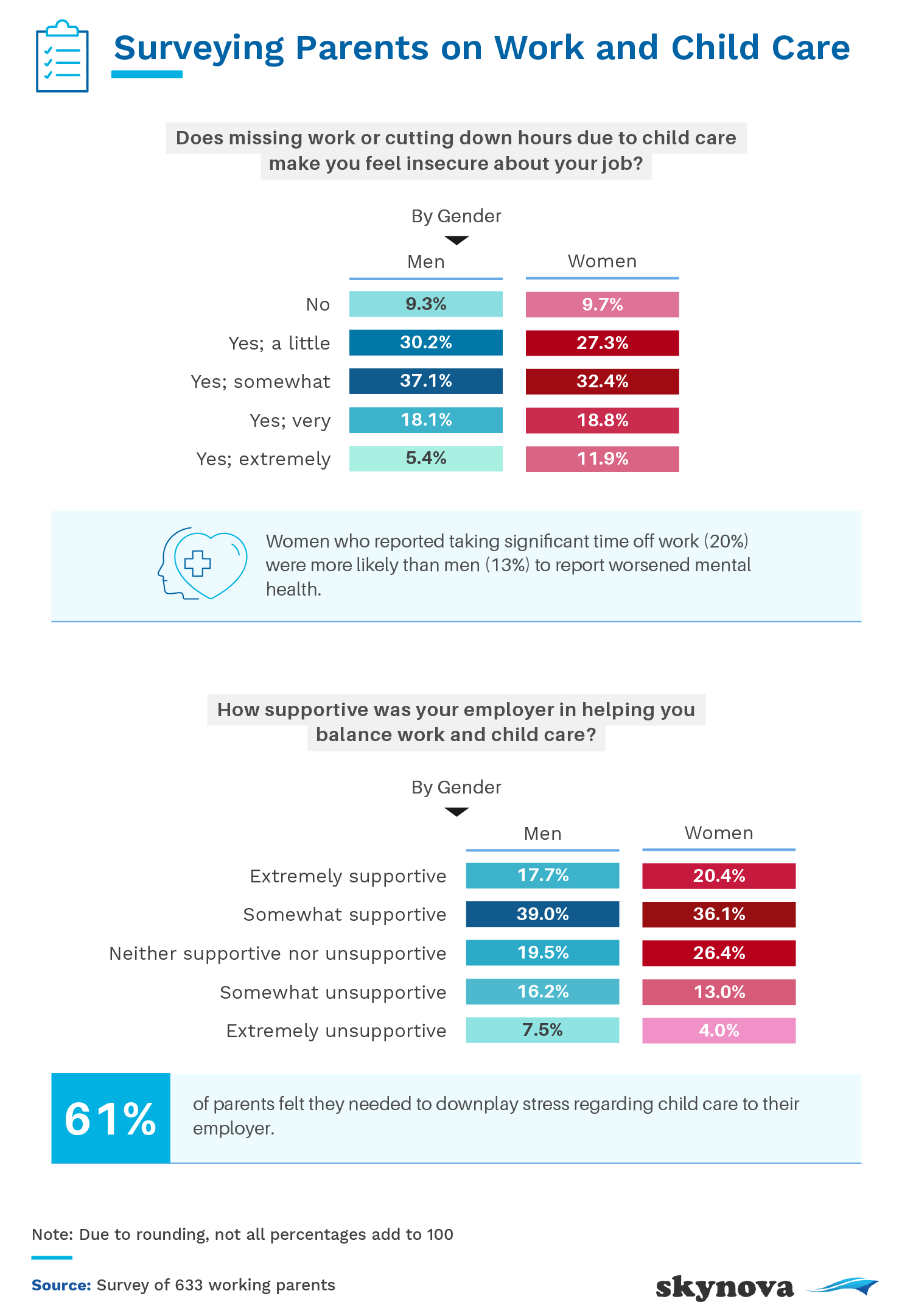
|
Finding balance between work and family can be tricky, and the global pandemic has made it increasingly difficult for parents across America to find a happy medium. In fact, a recent survey shows that since the pandemic began, more than half of parents or family caregivers spend more time taking care of their children than ever before.
Now, while child care isn't a bad thing, many adults simply can't afford to work while simultaneously assuming their responsibility as parents. We'll take a closer look at the gender differences in relation to who's taking more time off to assume the caretaker role, while analyzing variations by industry and state and assessing opinions about people's insecurity when taking time off work.
In the week prior to completing the survey, 2.8% of respondents took some time off work at some point to look after their children. During the last four weeks, 4.2% of them had not even been looking for work as they were too preoccupied with their kids. An additional 9.3% had to work part time to account for child care.

In all three categories, over 90% of respondents falling into the affirmative were women. The pandemic has been especially hard on women in terms of the work-life balance - women already shoulder the majority of caregiving responsibilities, and the added stress and consequences of COVID-19 have put many in a difficult spot. In fact, twice as many women than men who became unemployed due to the pandemic cited the reason as lack of child care. Many families cannot afford child care either, and access to it now is as difficult as ever. Unfortunately, many women have paid the price, as seen in the charts above.
Regarding employment status, 13.6% of parents said they work part time. The most common reason given was due to family and/or personal obligations, according to 27.7% of them. Just over 9% attributed it specifically to child care issues.

Among those working part time because of child care, most were from the public administration sector (14.2%). Slightly more men than women from this sector worked part time. The biggest discrepancy between men and women can be seen in the business and repair services industry - 15.5% of women worked part-time, compared to only 1.3% of men.
Naturally, full-time employees make more than part-time employees, on average. Due to child care, women working part time make around $30,000 less than those employed full time. The sacrifice that women make (i.e., transitioning to part-time work) in order to assume more child care responsibilities amounts to around $64.5 billion in lost wages and economic activity annually.
Let's take a look at the distribution of mothers working part time for child care purposes by state. Data shows that a quarter of New Jersey moms worked part time in order to tend to their children, closely followed by Montana at 23%, Washington, D.C., at 22%, and Michigan at 21%.

Some mothers were so preoccupied with child care responsibilities that they weren't looking for work at all. Thirty-four percent of unemployed Indiana mothers were in this position, 8% higher than the next leading state (New Mexico).
It would be safe to assume that many mothers have been suffering from burnout - they are 28% more likely to experience some degree of it than fathers. As previously mentioned, not many families can afford child care - only around 27% were able to hire a nanny or a babysitter. Without the necessary funds to bring in extra support, many mothers have unfortunately paid the price.
Parents were asked if taking time out of work to take care of their children instilled a sense of insecurity regarding their jobs. The majority of men and women felt this was either a little or somewhat true, but 11.9% of women felt extremely insecure about it, opposed to only 5.4% of men.

The majority of men and women also agreed that their employers were somewhat supportive in helping them balance child care and work, but just under 7 percent more women felt they had been impartial. Interestingly, slightly more men said their employers were either somewhat or extremely unsupportive.
Employers should consider different ways to maintain staff morale, especially to cater toward parents struggling with balancing work and child care. One way employers can refrain from losing their employees to child care needs is to provide better and equal benefits for parental leave, whether maternal or paternal. This can encourage all parents to positively recalibrate their work-life balance, regardless of gender.
Clearly, the already tough balance between work and life has been amplified by the global pandemic. Many have been forced to scale back into a part-time position, while some do not even have the opportunity to work at all. Mothers have especially been hit hard seeing as they tend to take on the caretaker role more so than fathers. Men and women also felt slightly insecure about taking time away from work for childcare-related purposes.
Looking ahead, employers should maximize their efforts on supporting parents by focusing on child care-related issues, such as standardizing parental leave and helping with costs elsewhere, if possible. Especially in the midst of a pandemic, parents deserve to be taken care of.
While Skynova helps businesses create professional-looking invoices, they also specialize in other services like accounting functions, work orders, and more for small businesses. With Skynova's 37 modules designed to work in harmony, managing all financial aspects of your business has never been easier. On top of this, we really enjoy producing content revolving around topics we, and hopefully you, enjoy. Generally, we like to pair the topic of business with another area of society - for example, the relationship between business and child care, as you've just learned about. We use various data sets such as surveys, statistics, and secondary research to bring our articles to life.
We analyzed IPUMS CPS data collected in 2020 and filtered results by those with children living in their household to see how parents were handling employment and child care. We used Basic Monthly survey data for all data points except those regarding salary status, in which we used the ASEC survey supplement that provides socioeconomic survey data. Data were weighted.
Further, we surveyed 633 parents ranging in age from 18 to 69 in order to explore how child care responsibilities affect employment and mental health. The mean age was 37. Forty-seven percent of our respondents identified as female, and 53% identified as male.
Survey data has certain limitations related to self-reporting. These limitations include telescoping, exaggeration, and selective memory. We didn't weight our own survey data or statistically test our hypotheses for this exploratory project.
Do you know someone who knows what it's like to juggle a job and kids at the same time? If you think your friends or family might appreciate this article, feel free to share it with them - we just ask that you do so for noncommercial use only. Also, please provide a link back to the original page so they have access to all the findings and methodology used.